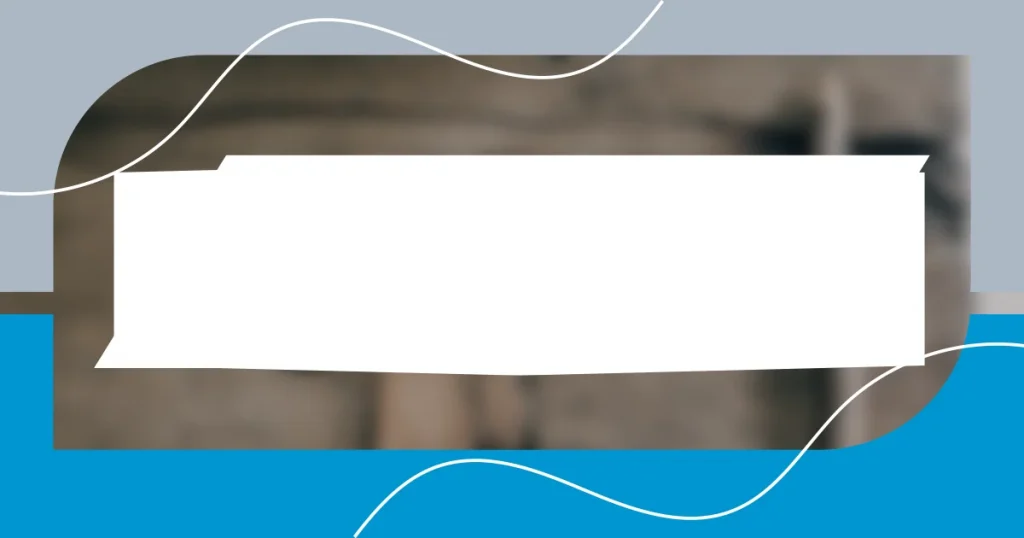Key takeaways:
- Preparation is crucial; sanding and testing the stain beforehand can significantly enhance the final outcome.
- Choosing the right type of stain, applicator, and finish directly impacts the aesthetics and durability of the project.
- Working with the grain and considering environmental conditions during application can prevent common staining issues and lead to better results.

Understanding staining techniques
Staining techniques can be an art form, blending science with creativity in the most remarkable ways. I remember the first time I attempted a staining project; I was nervous, unsure if I could achieve the beautiful depth of color I envisioned. Have you ever felt that rush of anxiety before starting something new? Those early attempts taught me the importance of choosing the right type of stain for the material and the effect I wanted to achieve.
There are various staining methods, from water-based to oil-based stains, each offering unique qualities and finishes. Personally, I gravitate toward water-based products because they are easier to clean up and have less odor. However, oil-based stains provide a richness that can be hard to replicate. Have you found yourself torn between different options? Understanding the nuances between these kinds of stains makes a world of difference in the final result.
I’ve learned that preparation is key in achieving successful staining techniques. I vividly recall a project where I skipped sanding, thinking it wouldn’t matter much; I couldn’t have been more wrong. The stain clung unevenly, revealing imperfections that I now know could have been avoided. Isn’t it fascinating how a little extra effort can elevate your work to a new level?

Importance of proper staining
The significance of proper staining cannot be overstated, as it greatly impacts the durability and aesthetics of the finished piece. I remember tackling a beautiful oak table where I mistakenly opted for a lighter stain without testing it first. The final outcome left me feeling disappointed and frustrated, realizing that even a minor oversight could ruin months of hard work. Have you encountered a similar situation where the choice of stain drastically affected your project?
Equally important is the technique employed during the staining process. I recall a time when I rushed through a project, forgetting to apply a pre-stain conditioner. The result was blotchy and uneven, and it left me feeling disheartened. It’s amazing how a simple step can truly transform the outcome. I believe that taking the time to refine your staining approach can lead to stunning results that you’ll be proud to showcase.
Lastly, choosing the right finish can make a world of difference, too. After a recent experience of using a glossy finish on a rustic piece, I learned that it overshadowed the natural beauty of the wood grain. It’s crucial to think about how the finish aligns with your vision for the project. How has your choice of finish influenced the perception of your work? Reflecting on these aspects has helped me refine my process over time, elevating every piece I create.
| Aspect | Importance |
|---|---|
| Choosing the Right Stain | Ensures desired color and enhances material properties |
| Application Technique | Affects the uniformity and depth of the stain |
| Finishing Touches | Complements the project and influences durability |

Types of common staining techniques
The world of staining techniques is diverse, with each method unfolding unique possibilities for transforming materials. In my journey as a maker, I’ve experimented with several approaches, each contributing to my growing confidence and skills. For instance, after a memorable weekend spent perfecting the gel stain technique, I was astonished by the depth of color I could achieve without the worry of drips and runs. I loved how it effortlessly adhered to vertical surfaces, sparking my passion even further.
Here are some common staining techniques I’ve come across:
- Oil-based Stains: These stains penetrate deeply, offering rich color and durability. I’ve enjoyed using them for furniture that endures heavy use.
- Water-based Stains: I’m particularly fond of these for their ease of cleanup and lower odor. I find they allow the wood grain to shine through beautifully.
- Gel Stains: Perfect for vertical surfaces, I appreciate how they prevent drips while providing a rich finish. They’ve become a staple in my toolkit.
- Wipe-on Stains: These are fantastic when you want to control the intensity and are great for quick projects.
- Lacquer Stains: I love the fast-drying aspect of these for a smooth finish, especially when I’m in a hurry to complete a project.
Diving into these techniques has opened up a new world of creativity for me. Each one invites experimentation, allowing me to express my style while enhancing the natural beauty of the wood. It’s exciting to think about what I might discover next!

Tools and materials needed
To achieve great results when staining, the right tools and materials are essential. I remember getting my first proper set of brushes; the difference they made was incredible. Instead of experiencing frustration from streaks and uneven applications, the brushes allowed me to apply the stain smoothly and evenly. Have you ever felt the satisfaction that comes from using quality tools?
When it comes to materials, the choice of wood conditioner can’t be overlooked. I learned this the hard way during a project with pine—without conditioning, the stain absorbed unevenly, creating dark patches that left me feeling defeated. Once I started using a pre-stain conditioner, my pieces transformed, enhancing the wood’s natural beauty without those pesky blotches. Don’t you think it’s fascinating how one small change can elevate your work?
Lastly, I can’t emphasize enough the value of protective gear. The first time I stained without gloves, my hands turned a shade of mahogany that took days to wash off. Wearing gloves and a mask now seems like common sense, but the experience taught me the importance of protecting both my health and the integrity of my project. How do you ensure you stay safe while getting creative?

Steps for effective staining
Before diving into staining, preparation is key. I vividly recall a time when I was eager to start a project but hastily skipped sanding the wood. The result? A splotchy finish that left me feeling frustrated and disappointed. Now, I take a moment to sand the surface thoroughly. It creates a smooth base and allows the stain to adhere better, transforming my projects into delightful creations.
Next, I always test the stain! I learned this lesson the hard way when a vibrant hue on a scrap piece turned out looking entirely different on the actual project. What a surprise that was! Now, I take the extra step to test my chosen stain in an inconspicuous area or on a scrap piece of wood. This small but vital action saves me from unwelcome surprises and helps me visualize the end result.
Finally, layering the stain is something I’ve grown to appreciate. Initially, I was tempted to rush and apply one thick coat, hoping for a quick finish. However, I soon discovered that applying several thin layers instead allows more control over the color depth. Each additional layer builds character and richness, much like the layers of a good story. Have you tried this technique? It changes how the wood whispers its personality, and I find it fascinating how patience pays off!

Troubleshooting common staining issues
It’s not uncommon to face issues like a blotchy finish or uneven color when staining, and I’ve definitely been there. I recall a furniture project where I hurried through the staining process, leading to unsightly splotches. It taught me the importance of taking my time and ensuring even application—now I always work in small sections with a rag to blend edges seamlessly. Have you ever noticed how a little extra care can prevent a headache later on?
Another challenge that often arises is over-application of stain, especially if you’re eager for that rich color. During one of my early projects, I got carried away and ended up with a sticky mess that wouldn’t dry properly. It was frustrating! Since then, I’ve learned to apply just enough stain and wipe off the excess promptly. This approach not only speeds up drying time but also prevents that dreaded tacky finish.
A common frustration I’ve experienced is staining that looks great initially but fades or evens out poorly later. I remember finishing a small shelf only to be disappointed when the color deepened a few days later. To combat this, I’ve started using a clear topcoat after staining, which not only enhances the color but adds necessary protection. Have you found a reliable finish that holds up over time? It can really make all the difference in enjoying the final result of your hard work.

Tips for achieving better results
When aiming for better results in staining, one crucial tip is to always work with the grain. I remember one project where I was so focused on speed that I stained against the grain, and the outcome was regrettably streaky. Now, I always pause to ensure my strokes follow the wood fibers. Have you ever noticed how this simple adjustment can elevate the finish remarkably?
Another important aspect is choosing the right applicator. In my early days, I used a brush for everything, only to find my wood absorbing unevenly. Switching to foam applicators or clean rags has been a game changer for me. They allow for smoother application and help avoid unwanted brush marks. It’s incredible how the right tool can make all the difference, don’t you think?
Finally, don’t underestimate the impact of environmental conditions. I once made the mistake of staining on a humid day, and the drying process was agonizingly slow. Now, I always check the forecast before starting a project. Finding a well-ventilated area with stable temperatures not only helps with drying but also promotes a flawless finish. It’s one of those behind-the-scenes tips that can save you a world of frustration. Have you tried considering the weather when staining? It’s a small detail that can really pay off!
















